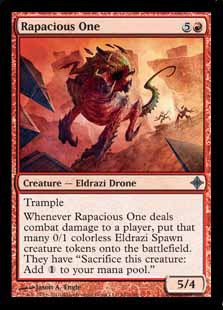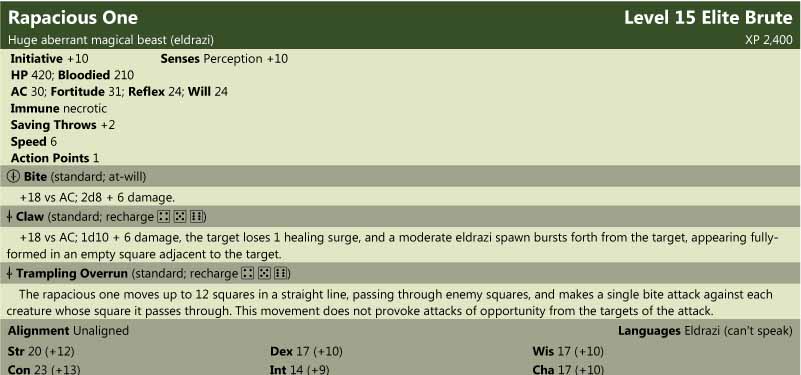Pre-Emptive Affirmation
May 31st, 2010
Hello everyone. After tallying the responses from the Mastering Dungeons article (parts 1 and 2) I've decided to try to incorporate more DM-related talk into Dark Designs. Today's topic isn't so much directly about DMing as it is about a particular aspect of DMing that also comes up a lot in design. If you're particularly new to DMing, you might learn a thing or two, but otherwise I hope only to entertain (and perhaps to inform a little about how we design things, of course). Look forward to seeing some articles aimed more specifically at DMs in the weeks ahead, especially tips on how to make good villains (as a necromancer, northwestern or otherwise, villainy is sort of my specialty). Speaking of villains, if you scroll down far enough, you might very well find statistics for the rapacious one.
There are numerous different styles to DMing, but somewhere in the middle of the 3.5 era the “collaborative play” style emerged as dominant over the others, at least in popularity. This school of thought proposes the (then) revolutionary idea that the DM is not playing against the players, and isn’t actually their secret foe, constantly rubbing his hands and twirling his moustache awaiting a TPK (total party kill), but is rather their friend, and is responsible for making sure that everyone enjoys the game. Under the collaborative play school of thought, the DM works together with the players to tell a story which is fun and exciting for everyone. Though it sounds kind of sappy (especially in some 4th edition supplements that go on for chapters about this style of dungeon mastering), it does tend to produce a more dynamic game than the older me-vs-them mindset, especially in games that aren’t just hack-and-slash dungeon crawls.
The golden rule of this style of play is that you should never tell a player “no,” because it disengages the player and devalues their input. I don’t mean that if they ask if there’s treasure in the room you always have to say yes. What I mean is, if a player asks you if they can do something, you should always do your best to try and accommodate them. Again, that doesn’t mean you have to let them succeed (if everyone always succeeded at everything they tried this would be freeform roleplay, not D&D) but it means you need to come up with a reasonable house rule on just what kind of check and DC it is to hang upside-down from a chandelier so you can fire on the people below you with your wand, or to shoot a bead of force attached to a flat-headed crossbow bolt through a peephole in a door.
The most common thing you don’t want to say “no” to is a player’s character concept. Though it will vary from player to player, most players will be much more engaged if they get to play the character they really want to play. Often players will want to play as a race that doesn’t exist in D&D, whether it’s something they saw in a different game or a tv show, a race they made up, or they may just want to play something really off-the-wall, like an awakened cat. In all the cases but the last, saying “no” would be easy, because, after all, there isn’t even a race for that. And, if you’re like me, you’re not exactly thrilled that the player wants to be running a catgirl (anime-style, with just the ears and tail) anyway. At the same time, if it will make your player more happy and engaged, is it really so terrible to slap a few changes on the halfling race (drop most of their racial features that aren’t ability score related, add some skill bonuses to perception, climb, acrobatics) and let your player be what he or she wants? (In the case of the cat, it’s not so much a matter of creating a race as it is bending the rules to let them play that cat at something a little more reasonable than the CR 2 an awakened cat would normally be.)
This philosophy is really at the heart of our design work here at Necromancers of the Northwest. “How can that possibly be,” you ask? “It doesn’t even make sense,” you say? Well, admittedly it’s a little different, but the underlying principle is the same. Here’s how I see it: every product we make has a specific goal that will, hopefully, make Pathfinder a better and more rounded game. Liber Vampyr was essentially written as a pre-emptive (and long-coming) “Yes” to anyone who ever wanted to play a vampire in D&D but was frustrated by how many hoops that required, as well as to anyone who ever wanted to play a different kind of vampire from the one in the bestiary (for simplicity’s sake I’ll use the easy example of the sparkling vampire, but there are others). Some of the content was just to round out the book (for example, Vampire Hunter is only there because we felt it ought to be, not because there’s any lack of undead-killing specialist prestige classes). In Into the Armory, we made an effort to say “Yes” to both players and DMs who wanted to use siege weapons but were off-put by the fact that the old system was needlessly complicated and not very effective. Along the way, though, we wound up making dozens of items designed to help promote specific styles of play, and which allowed players to do crazy-cool things, like spin a double-sword over their head to glide short distances.
Saying “Yes” in design is different from saying “Yes” at the table in that when a DM says “Yes” he can tailor the answer to his specific player and situation. In design, you have to make sure that your answers will work for large groups of people, and you have to make sure to include something for everyone. But that’s a story for another day.
And now, without further ado, the Rapacious One:

First for Pathfinder:
Rapacious One (CR 12)
XP 19,200
N Gargantuan aberration (extraplanar, eldrazi)
Init –2; Senses darkvision 60 ft., blindsight 60 ft.; Perception +18
DEFENSE
AC 26, touch 4, flat-footed 26 (–2 Dex, +22 natural, –4 size)
hp 184 (16d8+112)
Fort +12, Ref +3, Will +9
Immune: Negative energy
OFFENSE
Speed 40 ft.
Melee bite +21 (4d8+12/19–20 plus grab)
Space 20 ft.; Reach 15 ft.
Special Attacks swallow whole (4d8+18 bludgeoning damage plus eldritch consumption, AC 21, 20 hp)
STATISTICS
Str 35, Dex 6, Con 25, Int 2, Wis 8, Cha 8
Base Atk +12; CMB +28 (+32 grapple); CMD 36
Feats Awesome Blow, Critical Focus, Improved Bull Rush, Improved Critical (bite), Power Attack, Staggering Critical, Weapon Focus (bite), Ability Focus (eldritch consumption)
Skills Perception +18
SPECIAL ABILITIES
Eldritch Consumption (Su): At the beginning of each of its turns, all creatures in the rapacious one’s gullet must succeed on a DC 27 Fortitude save or take 1d4 points of Wisdom damage as the Eldrazi drains out its very life essence. For each point of Wisdom damage inflicted in this way, 1d6 Eldrazi spawn bubble and burst forth from the flesh of the rapacious one, landing fully-formed in the nearest unoccupied square. If a creature’s Wisdom damage equals or exceeds its Wisdom score while under the effects of Eldritch Consumption, the creature immediately dies and cannot be returned to life by anything short of a wish or miracle spell.
ECOLOGY
Environment any
Organization solitary
Treasure incidental
And then, for 4th edition:



